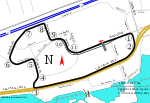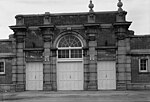2004 Molson Indy Toronto
2004 in Canadian motorsport2004 in Champ Car2004 in TorontoIndy Toronto

The 2004 Molson Indy Toronto was the sixth round of the 2004 Bridgestone Presents the Champ Car World Series Powered by Ford season, held on July 11, 2004 on the streets of Exhibition Place in Toronto, Ontario, Canada. Sébastien Bourdais swept the pole and the race win, his third consecutive win and fourth overall for the season. In doing so he also took over the lead in the drivers championship standings, a lead which he would not relinquish for the remainder of the season.
Excerpt from the Wikipedia article 2004 Molson Indy Toronto (License: CC BY-SA 3.0, Authors, Images).2004 Molson Indy Toronto
East Liberty Street, Toronto
Geographical coordinates (GPS) Address Nearby Places Show on map
Geographical coordinates (GPS)
| Latitude | Longitude |
|---|---|
| N 43.637222222222 ° | E -79.415555555556 ° |
Address
East Liberty Street 85
M6K 3P8 Toronto
Ontario, Canada
Open on Google Maps







